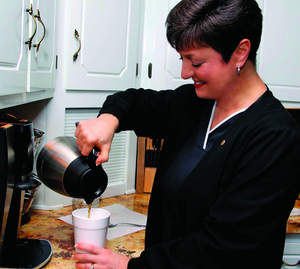MISSION, KS--(Marketwired - Feb 6, 2014) - (Family Features) Despite her career as a scrub nurse for general cancer surgeries, a personal diagnosis of cancer still came as a surprise.
"It was a surreal moment to be on the other side of the surgery table and faced with a cancer diagnosis," said Sheila Brake, who was diagnosed seven years ago with chronic lymphocytic leukemia (CLL), a common type of blood cancer. "It gave me a real appreciation for the confusion, fear and anxiety my patients feel at their time of vulnerability."
Many people confronted with a new cancer diagnosis face unfamiliar medical terminology and treatment decisions. Even as a scrub nurse, Sheila faced similar fears.
"It's nearly impossible at first to get your head around the reality of a cancer diagnosis," Sheila said. "I found it was crucial to educate myself about my disease, the new terms, and to have an open, trusting dialogue with my oncologist to figure out the best treatment plan for me."
CLL, the most common type of adult leukemia, is a chronic disease that typically affects older adults. Symptoms vary and may take years to appear.1,2,3
"I was lucky that I didn't happen to have pre-existing medical conditions," she said. "In my case, we decided on the 'watch-and-wait' approach, where no active treatment was actually given until the disease and symptoms got worse."
Almost three years later, Sheila initiated her treatment regimen and feels lucky she was able to continue her work in the surgery room and day-to-day life alongside her husband and two dogs until she reached remission.
Since CLL is chronic and incurable, many people require additional treatment due to the return of cancerous cells.1 Sheila said that while the possibility of relapse weighs on her sometimes, she has hope for the future.
"My oncologist told me researchers are working on even more therapies, which is amazing and will give folks more options," she said.
CLL Facts:
- A cancer that starts in the blood and bone marrow.3
- More than 4,500 deaths are expected in the U.S. during 2014.4
- The average age of diagnosis is 71, and is rarely seen in people under age 40.2
For more information about CLL and other blood cancers like non-Hodgkin's lymphoma, talk with your doctor or visit the Leukemia and Lymphoma Society website at http://www.lls.org or the Lymphoma Research Foundation website at http://www.lymphoma.org.
References
1. Dighiero G and Hamblin T. Chronic Lymphocytic Leukemia. The Lancet. 2008; 371:1017-1029.
2. National Cancer Institute. SEER Stat Fact Sheet: Chronic Lymphocytic Leukemia. http://seer.cancer.gov/statfacts/html/leuks.html. Accessed January 2, 2014.
3. Leukemia and Lymphoma Society. Chronic Lymphocytic Leukemia: Disease Information & Support. http://www.lls.org/#/diseaseinformation/leukemia/chroniclymphocyticleukemia/. Accessed January 2, 2014.
4. Siegel, R., Ma, J., Zou, Z., & Jemal A. (2014). Cancer Statistics, 2014. CA: A Cancer Journal for Clinicians, 1-22. http://onlinelibrary.wiley.com/doi/10.3322/caac.21208/pdf. Accessed January 7, 2014.
About Family Features Editorial Syndicate
This and other food and lifestyle content can be found at www.editors.familyfeatures.com. Family Features is a leading provider of free food and lifestyle content for use in print and online publications. Register with no obligation to access a variety of formatted and unformatted features, accompanying photos, and automatically updating Web content solutions.
Contact Information:
Vickie Rocco
vrocco@familyfeatures.com
1-888-824-3337
http://editors.familyfeatures.com
